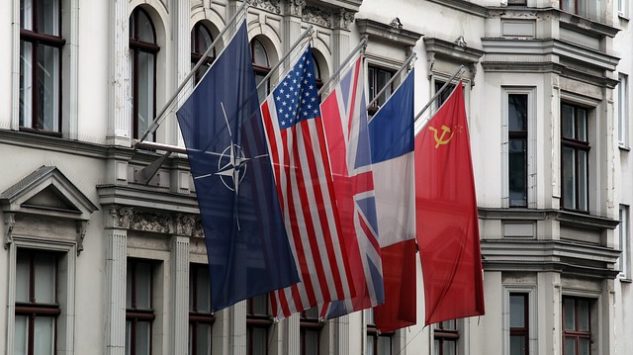Issue Briefs

The Invisible Giant That Dominates Eurasia
Martin Sieff
April 4, 2019
The largest military organization in the history of the world has just announced its annual main military exercises. And the organization is not NATO. The decision to hold the joint exercise — “Sary-Arka-Antiterror 2019” — was announced the day before during the 34th meeting of the Regional Anti-Terrorist Structure (RATS) council of the Shanghai Cooperation Organization (SCO) in Tashkent, capital of Uzbekistan. Delegations from India, Kazakhstan, China, the Kyrgyz Republic, Pakistan, Russia, Tajikistan and Uzbekistan attended the meeting, the report said.
“Anti-Terrorist Exercises”?
Such “anti-terrorist exercises” are usually held on an annual basis. But they are a lot larger than the term “anti-terrorist” might suggest. Previous such SCO exercises have involved the paratroop drop of thousands of troops and practiced amphibious landings on potentially hostile shores. In other words, these regular maneuvers are not just “anti-terrorist exercises,” they are full scale war games.
The 28 nations of NATO include one major thermonuclear power (the United States) and two minor thermonuclear powers (the disintegrating United Kingdom and France). They have a total of 29 members with a combined total population of around 880 million people. That sounds like a lot.
In contrast, the Shanghai Cooperation Organization comprises only eight nations; but four of them are major thermonuclear superpowers (Russia, China, India and Pakistan), and they have a combined population of more than 3 billion people, with vastly larger combined standing armies than the NATO nations do.
NATO does not help the US
NATO – applying the concepts of the great 20th century British historian Lord Correlli Barnett, Prime Minister Margaret Thatcher’s favorite historian – is therefore not a supplier of additional security to the United States.
On the contrary, this Alliance drains strength and security from the United States, forcing it to defend more than two dozen allies, only one of which (Turkey) is a significant land military power, and only two of which are first rank military power; while only two (Canada and the UK) have the ability to project even small military forces rapidly around the world. Most of the other NATO members are, in military terms, defenseless jokes.
SCO growing bigger and stronger
By contrast, as Ewa Seiwart of the Freie Universitat Berlin wrote in “The Diplomat” on March 23, the SCO has now grown “into the largest regional organization both in terms of its geographical coverage (over 60 percent of the Eurasian landmass), and population (almost half of the world’s population), with its collective gross domestic product amounting to almost 25 percent of the global total.”
This is a far larger, more populous and incomparably wealthier and more militarily powerful power bloc than the Soviet Union and its Warsaw Pact satellites ever were at the height of the Cold War. It also contains the largest concentration of industrial productive capacity on the planet: and that is in Heartland China, primarily centered in the southeast Guangdong region. Throughout the Cold War it was the Northeast and Midwest “Foundry” regions of the United States which enjoyed that distinction.
The SCO, founded in June 2001, is not only enormous: It is growing fast. Less than two years ago it literally doubled in size and population with the accession of India and Pakistan, traditional existential enemies]. When that happened, the World was transformed but nobody in the West noticed.
India and Pakistan joined
India has a population of 1.324 billion and Pakistan of 193.2 million people (both in 2016). In other words, in 2017, the combined population of the SCO powers or already well over 1.5 billion, virtually doubled at a single stroke.
The long-term global consequences of this development are enormous. It is likely to prove the single most important factor insuring peace and removing the threat of nuclear war over South Asia, and from 20 percent of the human race. It now raises the total population of the world within the eight SCO nations to 40 percent, including one of the two most powerful thermonuclear armed nations (Russia) and three other nuclear powers (China, India and Pakistan).
This development is a diplomatic triumph –especially for Moscow. Russia has been seeking for decades to ease its longtime close strategic ally India into the SCO umbrella. This vision was clearly articulated by one of Russia’s greatest strategic minds of the 20th century, former Premier and Foreign Minister Yevgeny Primakov, who died in 2015. In the past China quietly but steadfastly blocked India’s accession; but with Pakistan, China’s ally joining at the same time as India did, the influence of Beijing and Moscow over the SCO is harmonized.
Russia’s leverage increased
The move can only boost Russia’s already leading role in the diplomacy and national security of the Asian continent. For both Beijing and Delhi, the road for good relations with each other and the resolution of issues, such as sharing the water resources of the Himalayas and investing in the economic development of Africa, now runs through Moscow. President Vladimir Putin is ideally placed to be the regular interlocutor between the two giant nations of Asia.
Moving closer to other major Asian countries must be seen as a most significant reaction by India to the increasing volatility and unpredictability of the United States in the global arena. In Washington and Western Europe, it is fashionable and indeed reflexively inevitable that this new turmoil is entirely blamed on President Donald Trump.
US unpredictable behavior caused anxieties in Asia
But, this alarming trend goes back at least to the bombing of Kosovo by the United States and its NATO allies in 1999. This was a military action in defiance of international law, because other permanent members of the United Nations Security Council opposed it.
Since then, under four successive presidents, the US appetite for unpredictable military interventions around the world – usually bungled and open-ended – has inflicted suffering and instability on a wide range of nations, primarily in the Middle East (Iraq, Syria, Libya and Yemen) but also in Eurasia (Ukraine) and South Asia (Afghanistan).
The accession of both India and Pakistan to the SCO is also a stunning repudiation of the United States’ global leadership.
Pakistan used to be a friend
The US has been Pakistan’s main strategic ally and protector over the past more than 70 years since it achieved independence (Dean Acheson, secretary of state through the 1949-53 Truman administration was notorious for his racist contempt for all Indians, as well as for his anti-Semitism and hatred of the Irish).
US-Pakistan relations have steadily deteriorated even since the United States charged into Afghanistan in November 2001, but through it all, US policymakers have always taken for granted that Islamabad at the end of the day would “stay on the reservation” and ultimately dance to their tune. Pakistan’s accession to the SCO showed that is no longer the case.
Failure to coopt India
The United States has courted India for 19 years since President Bill Clinton’s state visit in 2000, (which I covered in his press party). Current Indian Prime Minister Narendra Modi addressed a Joint Session of Congress in 2016, the ultimate accolade of approval by the US political establishment for any foreign leader.
US policymakers and pundits have endlessly pontificated that India, as an English-speaking democracy, would become America’s ideological and strategic partner in opposing the inevitable rise of China on the world stage. It turned out to be a fantasy.
During the Cold War, the “loss” of any nation of the size and standing of India or Pakistan to a rival or just independent ideological camp and security grouping would have provoked waves of shock, hurt, rage and even openly expressed fear in the US media.
Washington does not get any of this
However, what we have seen following this latest epochal development is far more extraordinary. The decisions by Delhi and Islamabad have not been praised, condemned or even acknowledged in the mainstream of US political and strategic debate. They have just been entirely ignored. To see the leaders and opinion-shapers of a major superpower that still imagines itself as the dominant hyper-power conduct its affairs in this way is potentially worrying and alarming.
The reality is that we live in a multipolar world – and that we have clearly been in this new environment since at least since 2001. However, this obvious truth continues to be denied in Washington, London and Paris in flat defiance of the abundantly clear facts.
Such an attitude is obviously not just childish, it is infantile. But far worse, it is extremely dangerous.
Avoiding reality may lead to bad outcomes
Sigmund Freud taught us that suppressed perceptions and the deliberate will not to see disturbing and inconvenient facts leads directly to irrational and self-destructive behavior. When practiced by major world governments, such states of mind can directly threaten world peace.
The United States and the NATO Alliance cannot go on pretending they dominate the world, and that they have the power to coerce other nations with different political systems and governing philosophies into doing things their way. If maintained, such attitudes can only end in catastrophe. In terms of classic Greek philosophy and drama, such Hubris, or arrogance can only lead to Nemesis – total destruction.
We are almost there.
 |
Martin Sieff is a Global Policy Institute Fellow. He is author most recently of Gathering Storm: The Seventh Era of American History and the Coming Crises That Will Lead to It. |
The views and opinions expressed in this issue brief are those of the author.